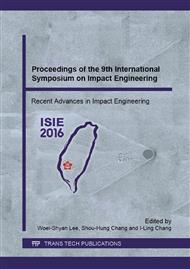[1]
United Nations Economic Commission for Europe Regulation No. 21, Uniform provisions concerning the approval of vehicles with regard to their interior fittings, (2003).
Google Scholar
[2]
R. Mullen, T. Belytschko, An analysis of an unconditionally stable explicit method, Computers & Structures, 16: 6 (1983) 691-696.
DOI: 10.1016/0045-7949(83)90060-3
Google Scholar
[3]
R.D. Cook, D.S. Malkus, M.E. Plesha, R.J. Witt, Concepts and Applications of Finite Element Analysis, 4th Edition, Wiley, (2001).
Google Scholar
[4]
T. Belytschko, H. -J. Yen, R. Mullen, Mixed methods for time integration, Computer Methods in Applied Mechanics and Engineering, 17-18 (1979) 259-275.
DOI: 10.1016/0045-7825(79)90022-7
Google Scholar
[5]
T.J.R. Hughes, K.S. Pister, R.L. Taylor, Implicit-explicit finite elements in nonlinear transient analysis, Computer Methods in Applied Mechanics and Engineering, 17-18 (1979) 159-182.
DOI: 10.1016/0045-7825(79)90086-0
Google Scholar
[6]
X. Ling, H.P. Cherukuri, Stability analysis of an explicit finite element scheme for plane wave motions in elastic solids, Computational Mechanics, 29 (2002) 430-440.
DOI: 10.1007/s00466-002-0353-8
Google Scholar
[7]
J.R. Koteras, R.B. Lehoucq, Estimating the critical time step in explicit dynamics using the Lanczos method, International Journal for Numerical Methods in Engineering, 69: 13 (2007) 2780-2788.
DOI: 10.1002/nme.1865
Google Scholar
[8]
Z.Q. Cheng, J.G. Thacker, W.D. Pilkey, W.T. Hollowell, S.W. Reagan, E.M. Sieveka, Experiences in reverse-engineering of a finite element automobile crash model, Finite Elements in Analysis and Design, 37: 11 (2001) 843-860.
DOI: 10.1016/s0168-874x(01)00071-3
Google Scholar
[9]
G.R. Consolazio, J.H. Chung, K.R. Gurley, Impact simulation and full scale crash testing of a low profile concrete work zone barrier, Computers & Structures 81: 13 (2003) 1359-1374.
DOI: 10.1016/s0045-7949(03)00058-0
Google Scholar
[10]
L. Kwasniewski, C. Bojanowski, J. Siervogel, J.W. Wekezer, K. Cichocki, Crash and safety assessment program for paratransit buses, International Journal of Impact Engineering 36: 2 (2009) 235-242.
DOI: 10.1016/j.ijimpeng.2008.05.003
Google Scholar
[11]
C. -H. Liu, and K. -M. Lee, Dynamic modeling of damping effects in highly damped compliant fingers for applications involving contacts, ASME Journal of Dynamic Systems, Measurement and Control, 134 (2012) 011005-1-9.
DOI: 10.1115/1.4005270
Google Scholar
[12]
K. -M. Lee, C. -H. Liu, Explicit dynamic finite element analysis of an automated grasping process using highly damped compliant fingers, Computers and Mathematics with Applications, 64: 5 (2012) 965-977.
DOI: 10.1016/j.camwa.2012.02.033
Google Scholar
[13]
C. -H. Liu, W. Chen, W. Su, C. -N. Sun, Numerical and experimental analysis of the automated demolding process for PDMS microfluidic devices with high-aspect ratio micropillars, International Journal of Advanced Manufacturing Technology, 80: 1 (2015).
DOI: 10.1007/s00170-015-6959-8
Google Scholar
[14]
S. Tabacu, I. Tabacu, A. Hadar, Computational modelling of vehicle interior components for impact applications: Thickness analysis, International Journal of Crashworthiness, 16: 4 (2011) 421-438.
DOI: 10.1080/13588265.2011.606994
Google Scholar
[15]
X. Deng, S. Potula, H. Grewal, K.N. Solanki, M.A. Tschopp, M.F. Horstemeyer, Finite element analysis of occupant head injuries: Parametric effects of the side curtain airbag deployment interaction with a dummy head in a side impact crash, Accident Analysis & Prevention, 55 (2013).
DOI: 10.1016/j.aap.2013.03.016
Google Scholar
[16]
N. Li, H. Fang, C. Zhang, M. Gutowski, E. Palta, Q. Wang, A numerical study of occupant responses and injuries in vehicular crashes into roadside barriers based on finite element simulations, Advances in Engineering Software, 90 (2015) 22-40.
DOI: 10.1016/j.advengsoft.2015.06.004
Google Scholar
[17]
K.A. Danelson, A.J. Golman, A.R. Kemper, F.S. Gayzik, H.C. Gabler, S.M. Duma, J.D. Stitzel, Finite element comparison of human and Hybrid III responses in a frontal impact, Accident Analysis & Prevention, 85 (2015) 125-156.
DOI: 10.1016/j.aap.2015.09.010
Google Scholar


